The OCZ Vertex 3 Review (120GB)
by Anand Lal Shimpi on April 6, 2011 6:32 PM ESTRandom Read/Write Speed
The four corners of SSD performance are as follows: random read, random write, sequential read and sequential write speed. Random accesses are generally small in size, while sequential accesses tend to be larger and thus we have the four Iometer tests we use in all of our reviews.
Our first test writes 4KB in a completely random pattern over an 8GB space of the drive to simulate the sort of random access that you'd see on an OS drive (even this is more stressful than a normal desktop user would see). I perform three concurrent IOs and run the test for 3 minutes. The results reported are in average MB/s over the entire time. We use both standard pseudo randomly generated data for each write as well as fully random data to show you both the maximum and minimum performance offered by SandForce based drives in these tests. The average performance of SF drives will likely be somewhere in between the two values for each drive you see in the graphs. For an understanding of why this matters, read our original SandForce article.
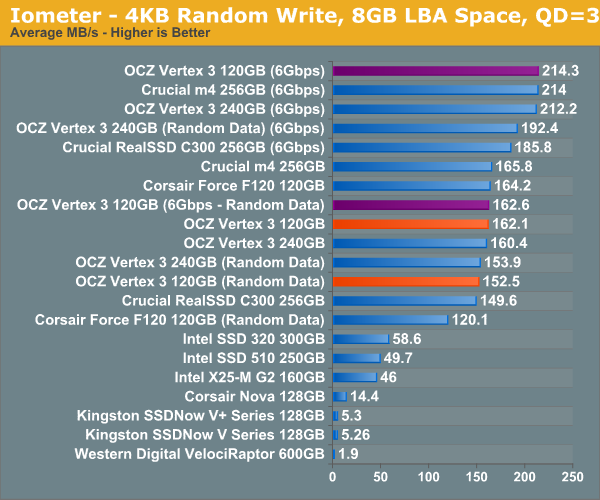
Peak performance on the 120GB Vertex 3 is just as impressive as the 240GB pre-production sample as well as the m4 we just tested. Write incompressible data and you'll see the downside to having fewer active die, the 120GB drive now delivers 84% of the performance of the 240GB drive. In 3Gbps mode the 240 and 120GB drives are identical.
Many of you have asked for random write performance at higher queue depths. What I have below is our 4KB random write test performed at a queue depth of 32 instead of 3. While the vast majority of desktop usage models experience queue depths of 0 - 5, higher depths are possible in heavy I/O (and multi-user) workloads:
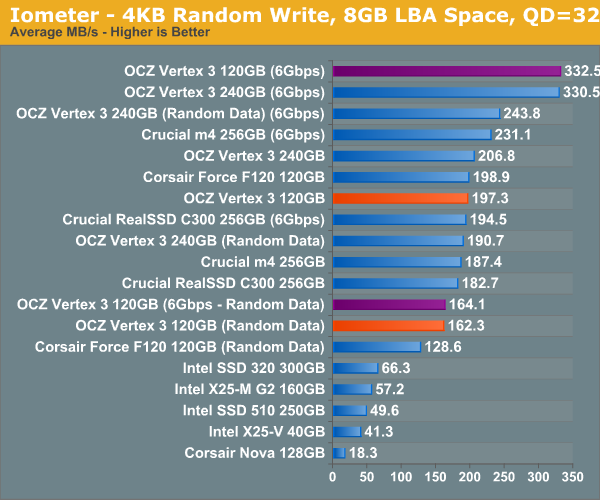
At high queue depths the gap between the 120 and 240GB Vertex 3s grows a little bit when we're looking at incompressible data.
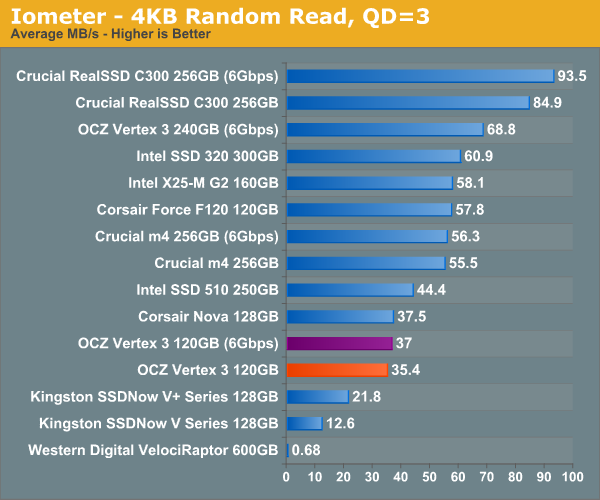
Random read performance is what suffered the most with the transition from 240GB to 120GB. The 120GB Vertex 3 is slower than the 120GB Corsair Force F120 (SF-1200, similar to the Vertex 2) in our random read test. The Vertex 3 is actually about the same speed as the old Indilinx based Nova V128 here. I'm curious to see how this plays out in our real world tests.
Sequential Read/Write Speed
To measure sequential performance I ran a 1 minute long 128KB sequential test over the entire span of the drive at a queue depth of 1. The results reported are in average MB/s over the entire test length.
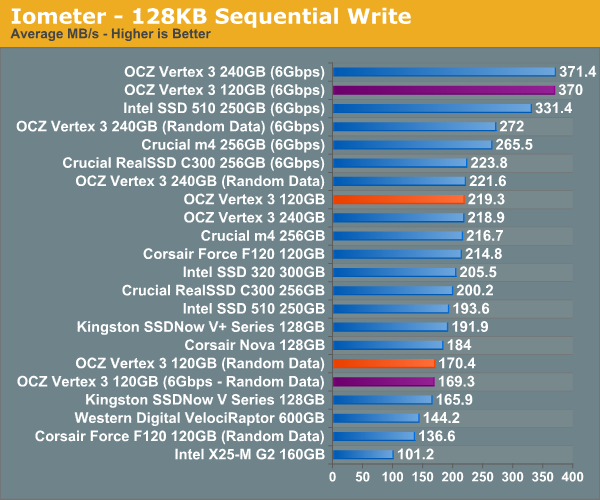
Highly compressible sequential write speed is identical to the 240GB drive, but use incompressible data and the picture changes dramatically. The 120GB has far fewer NAND die to write to in parallel and in this case manages 76% of the performance of the 240GB drive.
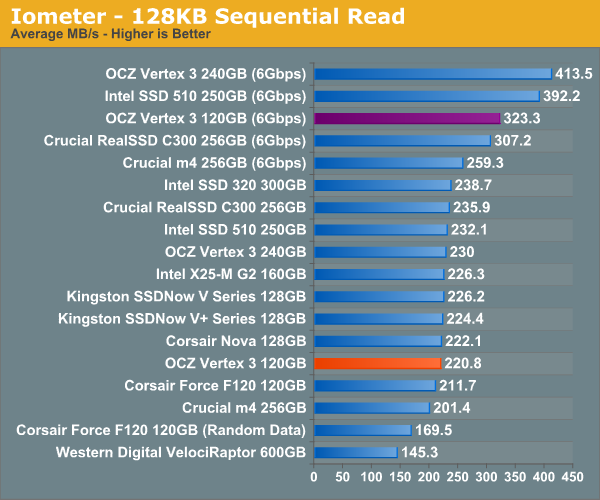
Sequential read speed is also lower than the 240GB drive. Compared to the SF-1200 drives there's still a big improvement as long as you've got a 6Gbps controller.










153 Comments
View All Comments
sor - Thursday, April 7, 2011 - link
Oh sure, I agree that the bottom line is whether or not it still works, that's why they do the binning and have grades of product within that brand. If OCZ can use cheaper flash and the controller takes care of the increased failures, or the users never reach the failure threshold, then who cares, as long as the product works the same?I can't speak for the testing procedures within SpekTek or their tolerances, as I only worked for a facility that tested parts for Micron, and in the process generated the bad parts and did some of the binning before sending them to SpekTek. Much of the stuff that went to them failed our tests but was otherwise not physically damaged.
There's a reason why those parts are sold under the SpecTek brand at a discount, it shows that even the manufacturer doesn't trust them to be sold under the good brand after testing.
Panlion - Thursday, April 7, 2011 - link
I wonder if OCZ will produce a 7mm 2.5 inch drive. The newer notebooks from Lenovo are starting to demand that format it'll be nice if I can have some option other than Intel SSD.sleepeeg3 - Thursday, April 7, 2011 - link
Maintaining integrity while sticking out for the little guy, instead of bending over backward to write glowing articles for every vendor sponsor. That's what has made this site succeed.I wish you could also take OCZ to task on SandForce's controller strange tendency to lock up and vanish from a system, due to built in encryption. They are in complete denial that it is an issue, despite dozens of reports on their user forums.
edfcmc - Thursday, April 7, 2011 - link
Thank you Anand for this very informative and in-depth review of the OCZ issue and their latest 120gb vertex 3 product; especially since the 120gb products are within my price range and the size I am looking to purchase. On a side note, I have been reading your reviews since your review of the FIC PA-2007 many years ago and I love the evolution of this site and your dedication to keeping us consumers informed.p.s. Please consider asking asus/Nvidia to update the Nvidia driver on their ULV80 series as nothing new has been updated since I purchased the UL80vt based on this site's recommendation. Asus/Nvida seem to be a little non-responsive to us folks who have been requesting an update for quite some time.
ekerazha - Thursday, April 7, 2011 - link
Can't wait for reviews of SSDs (Intel G3, Crucial m4) with comparable size (120 GB).Chloiber - Thursday, April 7, 2011 - link
Anand:Just a quick note. In the newest SF-firmware, there is also still a bug with Hynid Flash. You can see it here, under "Open Issues":
http://www.ocztechnologyforum.de/forum/showthread....
"Under benchmarking scenarios with IOMETER 2006, 60GB drives that use Hynix32nm MLC (1024 blocks, 8KB pages) can impose long latencies"
Just FYI.
MarcHFR - Thursday, April 7, 2011 - link
Dear OCZ, Dear Anand,In the past, it was simple :
Vertex : always the same NAND
Agility : NAND could change
I know that Vertex name is a best seller for OCZ, but i think it will be simplier to back to this
strikeback03 - Friday, April 8, 2011 - link
That is what I was wondering, I thought the point of the Agility line was that they would use the good controller but possibly cheaper NAND.Adul - Thursday, April 7, 2011 - link
Why not make use of QOR codes so a shopper can just scan the code to be taken to a page with more detail information.miscellaneous - Thursday, April 7, 2011 - link
Given this particularly insidious paragraph:"OCZ will also continue to sell the regular Vertex 2. This will be the same sort of grab-bag drive that you get today. There's no guarantee of the NAND inside the drive, just that OCZ will always optimize for cost in this line."
Will these "grab-bag" drives be using the same SKU(s)/branding as the original - well reviewed - Vertex 2? If so, how is using the _old_ SKU(s) to identify the _new_ "grab-bag" drives, whilst introducing _new_ SKU(s) to help identify drives with the _old_ level of performance a satisfactory solution?